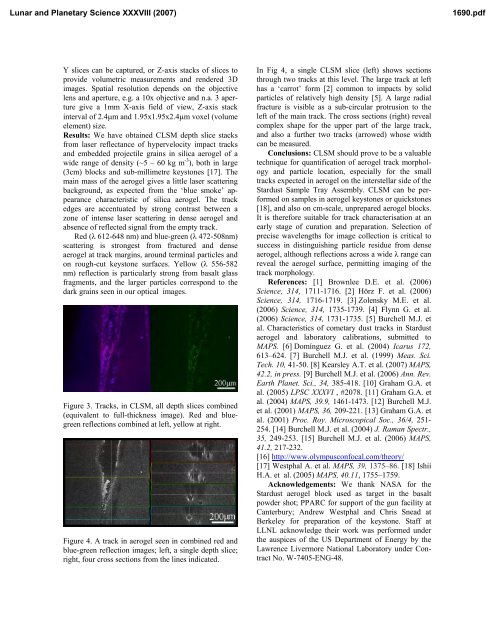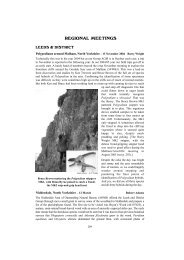Lunar and Planetary Science XXXVIII (2007) 1690.pdf
Lunar and Planetary Science XXXVIII (2007) 1690.pdf
Lunar and Planetary Science XXXVIII (2007) 1690.pdf
Create successful ePaper yourself
Turn your PDF publications into a flip-book with our unique Google optimized e-Paper software.
<strong>Lunar</strong> <strong>and</strong> <strong>Planetary</strong> <strong>Science</strong> <strong>XXXVIII</strong> (<strong>2007</strong>) <strong>1690.pdf</strong><br />
Y slices can be captured, or Z-axis stacks of slices to<br />
provide volumetric measurements <strong>and</strong> rendered 3D<br />
images. Spatial resolution depends on the objective<br />
lens <strong>and</strong> aperture, e.g. a 10x objective <strong>and</strong> n.a. 3 aperture<br />
give a 1mm X-axis field of view, Z-axis stack<br />
interval of 2.4µm <strong>and</strong> 1.95x1.95x2.4µm voxel (volume<br />
element) size.<br />
Results: We have obtained CLSM depth slice stacks<br />
from laser reflectance of hypervelocity impact tracks<br />
<strong>and</strong> embedded projectile grains in silica aerogel of a<br />
wide range of density (~5 – 60 kg m -3 ), both in large<br />
(3cm) blocks <strong>and</strong> sub-millimetre keystones [17]. The<br />
main mass of the aerogel gives a little laser scattering<br />
background, as expected from the ‘blue smoke’ appearance<br />
characteristic of silica aerogel. The track<br />
edges are accentuated by strong contrast between a<br />
zone of intense laser scattering in dense aerogel <strong>and</strong><br />
absence of reflected signal from the empty track.<br />
Red (λ 612-648 nm) <strong>and</strong> blue-green (λ 472-508nm)<br />
scattering is strongest from fractured <strong>and</strong> dense<br />
aerogel at track margins, around terminal particles <strong>and</strong><br />
on rough-cut keystone surfaces. Yellow (λ 556-582<br />
nm) reflection is particularly strong from basalt glass<br />
fragments, <strong>and</strong> the larger particles correspond to the<br />
dark grains seen in our optical images.<br />
Figure 3. Tracks, in CLSM, all depth slices combined<br />
(equivalent to full-thickness image). Red <strong>and</strong> bluegreen<br />
reflections combined at left, yellow at right.<br />
Figure 4. A track in aerogel seen in combined red <strong>and</strong><br />
blue-green reflection images; left, a single depth slice;<br />
right, four cross sections from the lines indicated.<br />
In Fig 4, a single CLSM slice (left) shows sections<br />
through two tracks at this level. The large track at left<br />
has a ‘carrot’ form [2] common to impacts by solid<br />
particles of relatively high density [5]. A large radial<br />
fracture is visible as a sub-circular protrusion to the<br />
left of the main track. The cross sections (right) reveal<br />
complex shape for the upper part of the large track,<br />
<strong>and</strong> also a further two tracks (arrowed) whose width<br />
can be measured.<br />
Conclusions: CLSM should prove to be a valuable<br />
technique for quantification of aerogel track morphology<br />
<strong>and</strong> particle location, especially for the small<br />
tracks expected in aerogel on the interstellar side of the<br />
Stardust Sample Tray Assembly. CLSM can be performed<br />
on samples in aerogel keystones or quickstones<br />
[18], <strong>and</strong> also on cm-scale, unprepared aerogel blocks.<br />
It is therefore suitable for track characterisation at an<br />
early stage of curation <strong>and</strong> preparation. Selection of<br />
precise wavelengths for image collection is critical to<br />
success in distinguishing particle residue from dense<br />
aerogel, although reflections across a wide λ range can<br />
reveal the aerogel surface, permitting imaging of the<br />
track morphology.<br />
References: [1] Brownlee D.E. et al. (2006)<br />
<strong>Science</strong>, 314, 1711-1716. [2] Hörz F. et al. (2006)<br />
<strong>Science</strong>, 314, 1716-1719. [3] Zolensky M.E. et al.<br />
(2006) <strong>Science</strong>, 314, 1735-1739. [4] Flynn G. et al.<br />
(2006) <strong>Science</strong>, 314, 1731-1735. [5] Burchell M.J. et<br />
al. Characteristics of cometary dust tracks in Stardust<br />
aerogel <strong>and</strong> laboratory calibrations, submitted to<br />
MAPS. [6] Domínguez G. et al. (2004) Icarus 172,<br />
613–624. [7] Burchell M.J. et al. (1999) Meas. Sci.<br />
Tech. 10, 41-50. [8] Kearsley A.T. et al. (<strong>2007</strong>) MAPS,<br />
42.2, in press. [9] Burchell M.J. et al. (2006) Ann. Rev.<br />
Earth Planet. Sci., 34, 385-418. [10] Graham G.A. et<br />
al. (2005) LPSC XXXVI , #2078. [11] Graham G.A. et<br />
al. (2004) MAPS, 39.9, 1461-1473. [12] Burchell M.J.<br />
et al. (2001) MAPS, 36, 209-221. [13] Graham G.A. et<br />
al. (2001) Proc. Roy. Microscopical Soc., 36/4, 251-<br />
254. [14] Burchell M.J. et al. (2004) J. Raman Spectr.,<br />
35, 249-253. [15] Burchell M.J. et al. (2006) MAPS,<br />
41.2, 217-232.<br />
[16] http://www.olympusconfocal.com/theory/<br />
[17] Westphal A. et al. MAPS, 39, 1375–86. [18] Ishii<br />
H.A. et al. (2005) MAPS, 40.11, 1755–1759.<br />
Acknowledgements: We thank NASA for the<br />
Stardust aerogel block used as target in the basalt<br />
powder shot; PPARC for support of the gun facility at<br />
Canterbury; Andrew Westphal <strong>and</strong> Chris Snead at<br />
Berkeley for preparation of the keystone. Staff at<br />
LLNL acknowledge their work was performed under<br />
the auspices of the US Department of Energy by the<br />
Lawrence Livermore National Laboratory under Contract<br />
No. W-7405-ENG-48.
















